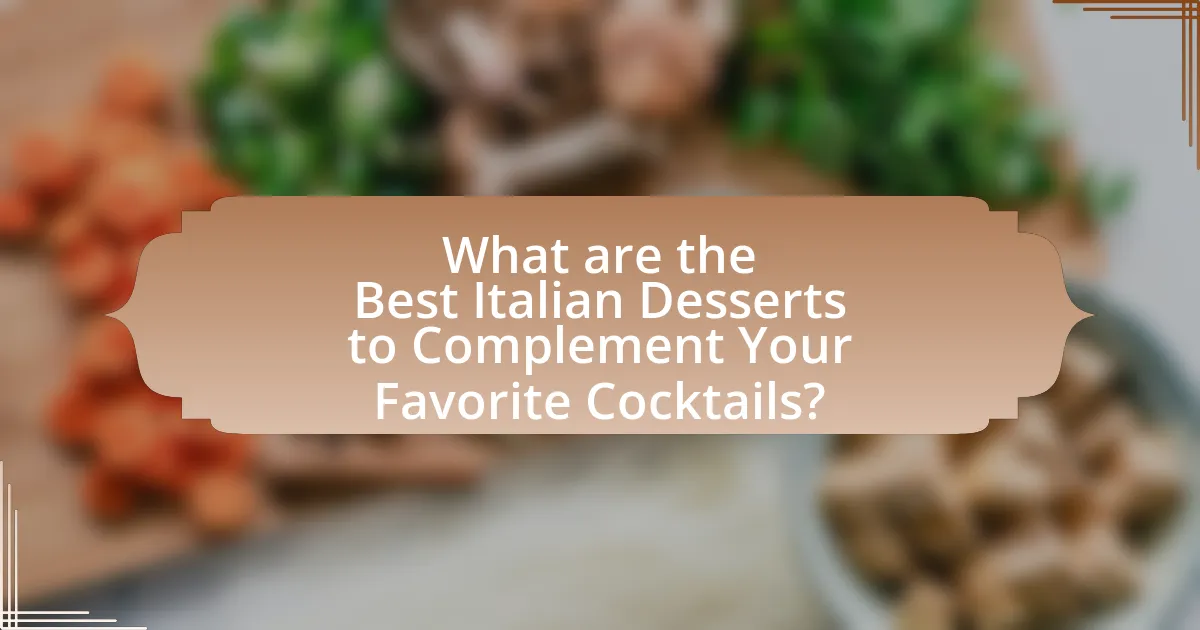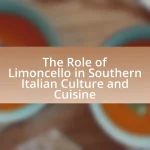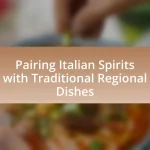The article focuses on the best Italian desserts that complement various cocktails, highlighting classic options such as Tiramisu, Panna Cotta, and Cannoli. It discusses how these desserts enhance the cocktail experience through complementary flavors and textures, as well as the importance of seasonal ingredients in pairing. Additionally, the article explores innovative dessert trends, fusion creations, and practical tips for selecting the right dessert to match specific cocktails, while also addressing common pairing mistakes to avoid. Overall, it provides a comprehensive guide to harmonizing Italian desserts with cocktails for an elevated dining experience.

What are the Best Italian Desserts to Complement Your Favorite Cocktails?
The best Italian desserts to complement your favorite cocktails include Tiramisu, Panna Cotta, and Cannoli. Tiramisu, with its coffee and mascarpone layers, pairs well with coffee-based cocktails like Espresso Martinis. Panna Cotta, a creamy dessert often flavored with vanilla or fruit, complements fruity cocktails such as Bellinis. Cannoli, filled with sweet ricotta and often garnished with chocolate or pistachios, enhances the experience of dessert wines or sweet aperitifs. These pairings are rooted in traditional Italian cuisine, where the balance of flavors is essential for a harmonious dining experience.
How do Italian desserts enhance the cocktail experience?
Italian desserts enhance the cocktail experience by providing complementary flavors and textures that elevate the overall tasting profile. For instance, desserts like tiramisu, with its rich coffee and mascarpone layers, pair well with coffee-based cocktails, creating a harmonious blend of flavors. Additionally, the sweetness of panna cotta can balance the bitterness of certain cocktails, such as Negronis, making the drinking experience more enjoyable. The use of fresh ingredients, like citrus in lemon sorbet, can also refresh the palate between sips, enhancing the cocktail’s appeal. These pairings are rooted in Italian culinary tradition, where the balance of flavors is essential, thus reinforcing the idea that Italian desserts are not just sweet endings but integral components of a well-rounded cocktail experience.
What flavors in Italian desserts pair well with cocktails?
Flavors in Italian desserts that pair well with cocktails include citrus, coffee, and chocolate. Citrus flavors, such as lemon and orange, enhance refreshing cocktails like gin and tonic or spritzers, providing a bright contrast. Coffee flavors, often found in desserts like tiramisu, complement rich spirits like whiskey or rum, creating a balanced taste experience. Chocolate, especially dark chocolate, pairs well with cocktails featuring spirits like vodka or brandy, as the bitterness of the chocolate enhances the complexity of the drink. These flavor combinations are widely recognized in culinary practices, making them effective choices for pairing Italian desserts with cocktails.
How do textures of desserts influence cocktail enjoyment?
Textures of desserts significantly influence cocktail enjoyment by enhancing the overall sensory experience. Creamy textures, such as those found in panna cotta, can create a smooth mouthfeel that complements the crispness of cocktails like Prosecco spritzers. Conversely, crunchy textures, such as those in biscotti, can add an interesting contrast to the liquid nature of cocktails, making the pairing more dynamic. Research indicates that texture affects taste perception; for example, a study published in the journal “Food Quality and Preference” found that varying textures can alter flavor intensity and enjoyment levels. Thus, the interplay between dessert textures and cocktail characteristics can elevate the drinking experience by engaging multiple senses.
What are some classic Italian desserts to consider?
Classic Italian desserts to consider include tiramisu, panna cotta, cannoli, and zabaglione. Tiramisu, a coffee-flavored dessert, combines layers of mascarpone cheese and espresso-soaked ladyfingers, originating from the Veneto region. Panna cotta, a creamy custard, is often flavored with vanilla and served with fruit coulis, showcasing its roots in Northern Italy. Cannoli, originating from Sicily, consist of crispy pastry shells filled with sweet ricotta cheese, often enhanced with chocolate chips or candied fruit. Zabaglione, a light custard made from egg yolks, sugar, and sweet wine, is traditionally served warm and highlights the Italian penchant for rich, flavorful desserts.
What is Tiramisu and how does it pair with cocktails?
Tiramisu is a classic Italian dessert made from layers of coffee-soaked ladyfingers and a rich mixture of mascarpone cheese, eggs, and sugar, often flavored with cocoa powder. It pairs well with cocktails that complement its coffee and creamy flavors, such as espresso martinis or coffee-infused cocktails, which enhance the dessert’s coffee notes. Additionally, cocktails with a hint of sweetness, like amaretto sours, can balance the richness of tiramisu, creating a harmonious dining experience.
How does Panna Cotta complement different types of drinks?
Panna Cotta complements different types of drinks by providing a creamy, rich texture that balances the flavors of both sweet and bitter beverages. The dessert’s smooth vanilla flavor enhances cocktails like fruity spritzers or dessert wines, while its subtle sweetness contrasts nicely with bitter drinks such as espresso martinis or Negronis. This versatility is supported by culinary practices that highlight the pairing of creamy desserts with various drink profiles, enhancing the overall tasting experience.
What makes Cannoli a popular choice with cocktails?
Cannoli are a popular choice with cocktails due to their rich, creamy filling and crispy shell, which create a delightful contrast in textures that pairs well with various drink flavors. The sweet ricotta filling often infused with chocolate chips or citrus zest complements the bitterness of cocktails, enhancing the overall tasting experience. Additionally, the versatility of cannoli allows them to be enjoyed with a range of cocktails, from sweet dessert drinks to more robust options, making them a favored dessert pairing in Italian cuisine.
What modern Italian desserts are trending with cocktails?
Modern Italian desserts trending with cocktails include tiramisu, panna cotta, and cannoli. Tiramisu, with its coffee and mascarpone layers, pairs well with espresso martinis, enhancing the coffee flavor. Panna cotta, a creamy dessert, complements fruity cocktails like Bellinis, as its smooth texture balances the drink’s acidity. Cannoli, filled with sweet ricotta, is often enjoyed with dessert wines or sweet vermouth cocktails, creating a delightful contrast between the rich filling and the drink’s sweetness. These pairings reflect current culinary trends that emphasize flavor harmony and innovative combinations.
How do innovative flavors in Italian desserts attract cocktail lovers?
Innovative flavors in Italian desserts attract cocktail lovers by offering unique taste experiences that enhance the overall drinking experience. These desserts often incorporate unexpected ingredients, such as herbs, spices, and seasonal fruits, which can complement or contrast with the flavors of various cocktails. For instance, a dessert featuring basil or rosemary can harmonize with gin-based cocktails, while citrus-infused desserts can elevate the freshness of vodka drinks. The creativity in flavor combinations not only excites the palate but also encourages cocktail enthusiasts to explore new pairings, making the dining experience more memorable.
What are some examples of fusion desserts that blend Italian and cocktail cultures?
Examples of fusion desserts that blend Italian and cocktail cultures include tiramisu martini, limoncello panna cotta with gin-infused syrup, and Negroni sorbet. The tiramisu martini combines the classic Italian dessert with the cocktail by incorporating coffee liqueur and vodka, creating a creamy, boozy treat. Limoncello panna cotta, a traditional Italian dessert, is enhanced with gin-infused syrup, adding a botanical twist that complements the citrus flavor. Negroni sorbet takes the iconic Italian cocktail and transforms it into a refreshing frozen dessert, utilizing Campari, sweet vermouth, and gin, resulting in a unique and flavorful experience.
How can you choose the right Italian dessert for your cocktail?
To choose the right Italian dessert for your cocktail, consider the flavor profile and texture of both the dessert and the cocktail. For example, a rich, creamy dessert like tiramisu pairs well with a coffee-flavored cocktail, while a light, fruity dessert such as panna cotta complements citrus-based cocktails. The balance between sweetness and acidity is crucial; a sweet dessert can enhance a tart cocktail, while a less sweet option can provide contrast. Additionally, traditional pairings exist, such as serving cannoli with a sweet dessert wine like Vin Santo, which enhances the overall tasting experience.
What factors should you consider when pairing desserts with cocktails?
When pairing desserts with cocktails, consider the flavor profiles, sweetness levels, and textures of both the dessert and the cocktail. Flavor profiles should complement each other; for instance, a rich chocolate dessert pairs well with a bold whiskey cocktail, while a light fruit tart may suit a refreshing gin and tonic. Sweetness levels are crucial; a dessert that is overly sweet can clash with a cocktail that has a strong alcohol presence, so balance is key. Additionally, the texture of the dessert should harmonize with the cocktail; creamy desserts can be enhanced by crisp cocktails, creating a pleasing contrast. These factors ensure a cohesive tasting experience that enhances both the dessert and the cocktail.
How do seasonal ingredients affect dessert and cocktail pairings?
Seasonal ingredients significantly enhance dessert and cocktail pairings by ensuring freshness and flavor compatibility. For instance, using summer fruits like peaches or berries in desserts can create a vibrant contrast with cocktails that feature citrus or herbal notes, such as a basil-infused gin and tonic. This alignment of flavors not only elevates the overall dining experience but also reflects the natural availability of ingredients, which can lead to more sustainable and eco-friendly choices. Studies show that seasonal produce often contains higher nutrient levels and better taste profiles, making them ideal for crafting desserts that harmonize with cocktails, thereby enhancing both taste and presentation.
What tips can enhance your dessert and cocktail pairing experience?
To enhance your dessert and cocktail pairing experience, focus on balancing flavors and textures. Pair sweet desserts with cocktails that have complementary or contrasting flavors, such as a rich chocolate cake with a bitter espresso martini, which balances sweetness with bitterness. Additionally, consider the texture; a creamy dessert like panna cotta pairs well with a light, fizzy cocktail like Prosecco, creating a pleasant mouthfeel. Research indicates that flavor pairing based on acidity and sweetness can elevate the overall tasting experience, as seen in studies on food and beverage compatibility.
How can presentation elevate the enjoyment of desserts and cocktails?
Presentation can significantly elevate the enjoyment of desserts and cocktails by enhancing visual appeal and stimulating the senses. A well-presented dessert or cocktail engages the viewer, creating anticipation and excitement before consumption. Research indicates that visual aesthetics can influence taste perception; for instance, a study published in the journal “Food Quality and Preference” found that attractive food presentation can enhance the perceived flavor and overall enjoyment of a dish. This suggests that the way desserts and cocktails are arranged, garnished, and served can lead to a more pleasurable dining experience, making the act of eating and drinking more memorable.
What common mistakes should you avoid when pairing Italian desserts with cocktails?
When pairing Italian desserts with cocktails, avoid mismatching flavor profiles, as this can lead to an unbalanced taste experience. For instance, pairing a rich tiramisu with a light, citrusy cocktail may overshadow the dessert’s flavors. Additionally, avoid serving overly sweet cocktails with sweet desserts like panna cotta, as this can create a cloying effect. Instead, opt for cocktails that offer acidity or bitterness to complement the sweetness of the dessert. Lastly, do not overlook the importance of texture; pairing a creamy dessert with a cocktail that has a similar mouthfeel can enhance the overall experience, while contrasting textures can create an interesting dynamic.










